|
|
|
The goal of operations research is to provide a framework
for constructing models of decision-making problems, finding
the best solutions with respect to a given measure of
merit, and implementing the solutions in an attempt to
solve the problems. On this page we review the steps of
the OR Process that leads from a problem to a
solution. The problem is a situation arising in an organization
that requires some solution. The decision maker
is the individual or group responsible for making decisions
regarding the solution. The individual or group called
upon to aid the decision maker in the problem solving
process is the analyst.
|
Recognize the Problem
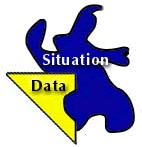 |
Decision making begins with
a situation in which a problem is recognized. The problem
may be actual or abstract, it may involve current operations
or proposed expansions or contractions due to expected
market shifts, it may become apparent through consumer
complaints or through employee suggestions, it may be
a conscious effort to improve efficiency or a response
to an unexpected crisis. It is impossible to circumscribe
the breadth of circumstances that might be appropriate
for this discussion, for indeed problem situations that
are amenable to objective analysis arise in every area
of human activity. |
The figure shows the situation with vague outlines because
most problems are poorly defined in their original conception.
Historical data describing organizational operations and performance
may be present in various forms. The data may be immediately
relevant to the situation or investigations may reveal the need
for additional data collection.
Formulate the Problem
| The first analytical step of the solution process is to
formulate the problem in more precise terms. |
|
At the formulation stage, statements of objectives,
constraints on solutions, appropriate assumptions, descriptions
of processes, data requirements, alternatives for action
and metrics for measuring progress are introduced. Because
of the ambiguity of the perceived situation, the process
of formulating the problem is extremely important. The
analyst is usually not the decision maker and may not
be part of the organization, so care must be taken to
get agreement on the exact character of the problem to
be solved from those who perceive it. There is little
value to either a poor solution to a correctly formulated
problem or a good solution to one that has been incorrectly
formulated.
We show an arc from the statement directly back to situation
because careful examination of a problem often leads to
solutions without complex mathematics. For complex situations
or for problems involving uncertainty, the OR process
usually continues to the next step. |
Construct a Model
In the above figure we show the problem statement with
more definition than the situation; however, greater simplification
is still necessary before a computer-based analysis can
be performed. This is achieved by constructing a model.
 |
A mathematical model is
a collection of functional relationships by which
allowable actions are delimited and evaluated. Although
the analyst would hope to study the broad implications
of the problem using a systems approach, a model cannot
include every aspect of a situation. A model is always
an abstraction that is, by necessity, simpler than
the reality. Elements that are irrelevant or unimportant
to the problem are to be ignored, hopefully leaving
sufficient detail so that the solution obtained with
the model has value with regard to the original problem.
The statements of the abstractions introduced in the
construction of the model are called the assumptions.
It is important to observe that assumptions are not
necessarily statements of belief, but are descriptions
of the abstractions used to arrive at a model. The
appropriateness of the assumptions can be determined
only by subsequent testing of the model’s validity.
Models must be both tractable -- capable of being
solved, and valid -- representative of the true situation.
These dual goals are often contradictory and are not
always attainable. We have intentionally represented
the model with well-defined boundaries to indicate
its relative simplicity. |
|
Find a Solution
|
The next step in the process is to solve the model
to obtain a solution to the problem. It is generally true
that the most powerful solution methods can be applied
to the simplest, or most abstract, model.
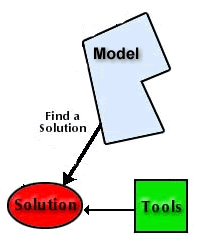 |
Here tools available to the analyst
are used to obtain a solution to the mathematical
model. Some methods can prescribe optimal solutions
while other only evaluate candidates, thus requiring
a trial and error approach to finding an acceptable
course of action. To carry out this task the analyst
must have a broad knowledge of available solution
methodologies. It may be necessary to develop new
techniques specifically tailored to the problem at
hand. A model that is impossible to solve may have
been formulated incorrectly or burdened with too much
detail. Such a case signals the return to the previous
step for simplification or perhaps the postponement
of the study if no acceptable, tractable model can
be found. |
Of course, the solution provided by the computer is only
a proposal. An analysis does not promise a solution but
only guidance to the decision maker. Choosing a solution
to implement is the responsibility of the decision maker
and not the analyst. The decision maker may modify the
solution to incorporate practical or intangible considerations
not reflected in the model. |
Establish the Procedure
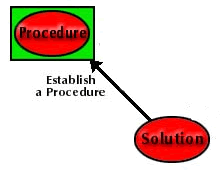 |
Once a solution is accepted a procedure must be designed to retain control
of the implementation effort. Problems are usually
ongoing rather than unique. Solutions are implemented
as procedures to be used repeatedly in an almost
automatic fashion under perhaps changing conditions.
Control may be achieved with a set of operating
rules, a job description, laws or regulations promulgated
by a government body, or computer programs that
accept current data and prescribe actions.
|
Once a procedure is established (and implemented), the
analyst and perhaps the decision maker are ready to tackle
new problems, leaving the procedure to handle the required
tasks. But what if the situation changes? An unfortunate
result of many analyses is a remnant procedure designed
to solve a problem that no longer exists or which places
restrictions on an organization that are limiting and
no longer appropriate. Therefore, it is important to establish
controls that recognize a changing situation and signal
the need to modify or update the solution. |
Implement the Solution
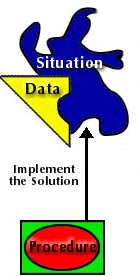 |
A solution to a problem
usually implies changes for some individuals in
the organization. Because resistance to change is
common, the implementation of solutions is perhaps
the most difficult part of a problem solving exercise.
Some say it is the most important part. Although
not strictly the responsibility of the analyst,
the solution process itself can be designed to smooth
the way for implementation. The persons who are
likely to be affected by the changes brought about
by a solution should take part, or at least be consulted,
during the various stages involving problem formulation,
solution testing, and the establishment of the procedure.
|
|
The OR Process
| Combining the steps we obtain the complete
OR process. In practice, the process may not be well defined
and the steps may not be executed in a strict order. Rather
there are many loops in the process, with experimentation
and observation at each step suggesting modifications
to decisions made earlier. The process rarely terminates
with all the loose ends tied up. Work continues after
a solution is proposed and implemented. Parameters and
conditions change over time requiring a constant review
of the solution and a continuing repetition of portions
of the process.
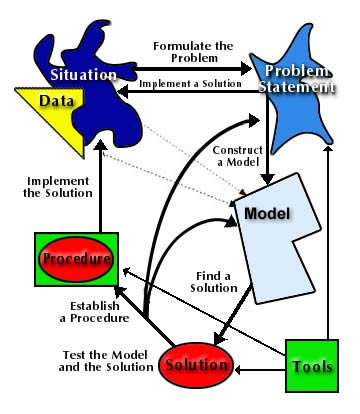 |
It is particularly
important to test the validity of the model and
the solution obtained. Are the computations being
performed correctly? Does the model have relevance
to the original problem? Do the assumptions used
to obtain a tractable model render the solution
useless? These questions must be answered before
the solution is implemented in the field. |
There are a number of ways to to test a solution. The
simplest determines whether the solution makes sense to
the decision maker. Solutions obtained by quantitative
studies may not be predictable but they are often not
too surprising. Other testing procedures include sensitivity
analysis, the use of the model under a variety of conjectured
conditions including a range of parameter values, and
the use of the model with historical data.
If the testing determines that the solution or model
is inappropriate, the process may return to the formulation
step to derive a more complex model embodying details
of the problem formerly eliminated through abstractions.
This may, of course, render the model intractable, and
it may be necessary to conclude that an acceptable quantitative
analysis is out of reach. It may also be possible to construct
a less abstract model and accept less powerful solution
methods. In many cases, finding a good or an acceptable
solution is almost as satisfactory as obtaining an optimal
one. This is particularly true when the quality of the
input data is low or when important parameters cannot
be specified with certainty.
Different organizations have different ways of approaching
a problem, and many do not admit quantitative techniques
or analysts as part of the process. It is important to
note, however, that in today’s world problems do
arise and decisions are made (even inaction is a decision
made by default). Many problems are solved in the first
step of our process, but there will be cases when complexity,
variability or uncertainty suggest that further analysis
is necessary. In these cases, the Operations Research
process will assist problem solving and decision making. |
|
|

